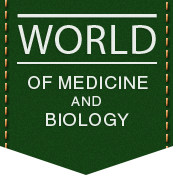| About the author: |
A. O. Polishchuk, S. B. Drozdovska, L. M. Hrubyak, M. M. Dolzhenko, V. E. Dosеnkо |
| Heading |
CLINICAL MEDICINE |
| Type of article |
Scentific article |
| Annotation |
Development of myocardium hypertrophy in athletes due to systematic physical training is multifactorial process vastly genetically determined. In this work, we studied DNA polymorphism and cardiac hypertrophy in professional athletes under physical activity with aerobic mode of energy supply. We have found that a group of athletes with hypertrophic alteration of the myocardium was characterized with increased frequency of the G/A gene polymorphism of PPARGC1A gene comparing to a group of athletes without pronounced changes of heart structure. The correlation between some polymorphism of genes and indices of echocardiography study was established: the correlation between G/C polymorphism of the PPARA gene and the middle septum thickness; correlation between Pro/Ala polymorphism of the PPARG gene and the left ventricular end-diastolic volume. By the method of binary logistic regression, a model for prognosis of effect on hypertrophy was established – 68.2 % including two polymorphisms: PPARG and UCP2. |
| Tags |
DNA polymorphism, myocardium hypertrophy, echocardiography, adaptation to physical load |
| Bibliography |
- Antomonov MY. Mathematical processing and analysis of biomedical data. Kyiv: 2006.558 s. [in Russian]
- Belotserkovskiy ZB, Liubyna BH. Serdechnaya deyatelnost i funktsionalnaya podgotovlennost u sportsmenov (norma i atipichnye izmeneniya v normalnykh i izmenennykh usloviyakh adaptatsii k fizicheskim nagruzkam). Мoskva:Soviet Sport Publ. 2012:548 s. [in Russian]
- Gavrilova EA. Stressornaya kardtomyopatiya u sportsmenov. European researcher. 2012; T.22 (6-2): 961-963. [in Russian]
- Hoshovska YuV, Lisovyi OO, Shymanska TV, Sahach VF. Zminy ekspresii heniv UCP2 tа UCP3, funktsionalnoho stanu і kysnevoyi vartosti roboty miokarda v umovakh starinnia ta ishemiyi – reperfuziyi. Fiziolohichnyi zhurnal. 2009; 55(3): 27−36. [in Ukrainian]
- Drozdovska SB. Asotsiatsiia G/C polimorfizmu 7-ho intronu henu α – retseptora shcho aktyvuye proliferatsiyu peroksysom (PPARA) z fizychnoyi diialnisti u sporti. Visn. “Problemy ekolohichnoyi ta medychnoyi henetyky i klinichnoyi imunolohiyi”. 2013; 3(117): 12−21. [in Ukrainian].
- Mykhailiuk EL, Syvolap VV. Sovremennye vzghliady na dyagnostiku metabolicheskoy kardiomiopatii vsledstvie khronycheskogo fizicheskogo perenapriazhenyia orhanizma sportsmenov. Sportivnaya Meditsina. 2014;1:3–12 [in Russian].
- Fulghum K, Hill BG. Metabolic Mechanisms of Exercise-Induced Cardiac Remodeling. FrontCardiovascMed. 2018;5:127.
- Gibb AA, Epstein PN, Uchida S, Zheng Y, McNally LA, Obal D, et al. Exercise-induced changes in glucose metabolism promote physiological cardiac growth. Circulation. 2017;136(22):2144–2157.
- Lichyan Tao, Yihua Bei, Haifeng Zhang, Junjie Xiao, Xinli Li. Exercise for the heart: signaling pathways. Oncotarget. 2015;6(25): 20773-−20784.
- Paterick T, Gordon T, Spiegel D. Echocardiography: Profiling of the Athlete`s Heart. Journal of the American Society of Echocardiography. 2014; 27(9):940−948.
- Weeks KL, McMullen JR. The athlete’s heart vs. The failing heart: Can signaling explain the two distinct outcomes? Physiology. 2011; 26:97–105.
|
| Publication of the article |
«World of Medicine and Biology» №2(76), 2021 year, 122-126 pages, index UDK 796.015.6:612.1+575.113.1 |
| DOI |
10.26724/2079-8334-2021-2-76-122-126 |
